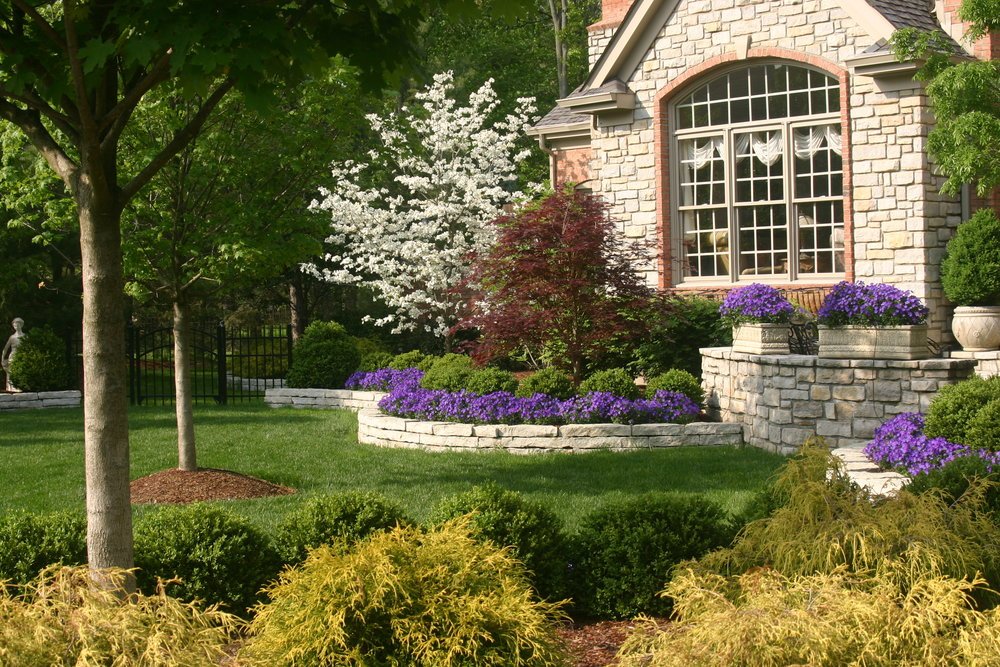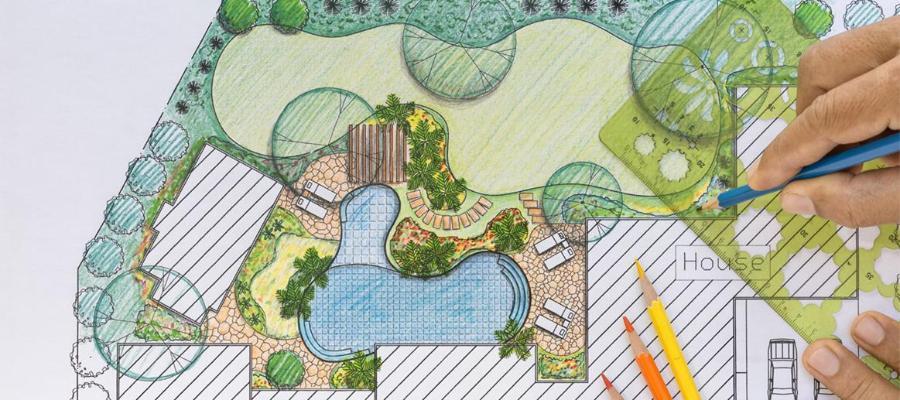Ogden Edge Design Company: Where Nature Fulfills Design in Landscape Quality
Ogden Edge Design Company: Where Nature Fulfills Design in Landscape Quality
Blog Article
Changing Your Landscape With Lasting Design
By integrating eco-friendly style components, selecting indigenous plants, and executing water preservation techniques, one can develop a greener and much more lasting landscape. In this discussion, we will discover the various advantages of lasting landscaping, dig into the means to integrate green design aspects, and share suggestions and tricks for keeping a sustainable garden. If you're looking to change your landscape right into a sustainable oasis, keep reviewing to uncover the secrets to accomplishing a greener and a lot more environmentally friendly outside area.
Advantages of Lasting Landscaping
Lasting landscape design uses countless advantages for both the setting and building proprietors. By including drought-tolerant plants and reliable watering systems, lasting landscaping minimizes water use substantially.
One more benefit of lasting landscaping is the decrease of chemical use. Typical landscape design commonly depends on chemicals and plant foods, which can damage the setting and human health and wellness. On the other hand, sustainable landscape design practices prioritize all-natural pest control approaches and natural fertilizers, reducing the need for harmful chemicals.

Finally, lasting landscaping can raise residential property worth. A well-designed lasting landscape not only improves the visual appeal of a building however additionally demonstrates a commitment to ecological responsibility. This can draw in potential buyers and renters that value lasting practices, causing higher residential or commercial property need and value.
Including Eco-Friendly Layout Elements
By integrating green style components, homeowner can enhance the sustainability of their landscapes while reducing their environmental effect. Green design elements concentrate on utilizing resources effectively, minimizing waste, and advertising biodiversity. One crucial element is water conservation. Installing rainwater harvesting systems and using drip irrigation can considerably decrease water usage. Native plants ought to likewise be prioritized in landscape design, as they are adapted to the local climate and require much less water and upkeep. In addition, including lasting materials is important. Utilizing recycled or recovered materials for hardscaping not only decreases waste however also adds an unique visual to the landscape. An additional crucial aspect is energy efficiency. Installing solar-powered lights or making use of low-energy LED lights can lessen energy consumption. Producing habitat for wild animals is a vital environmentally friendly design component (Ogden Edge Design Company). By including features such as bird feeders, insect resorts, and native growings, building owners can attract and support a varied series of wildlife. Including these environment-friendly design components not only profits the atmosphere yet likewise develops a attractive and sustainable landscape for homeowner to appreciate.
Finding Native Plants for a Sustainable Yard
When making a sustainable garden, one important facet to consider is the selection of native plants. Native plants are those that normally take place in a specific region or community and have adjusted to the neighborhood climate, soil conditions, and wildlife. By selecting indigenous plants for your yard, you can develop a low-maintenance and lasting landscape that profits both the setting and the neighborhood ecosystem.
Native plants have actually evolved over time to be well-suited to the local conditions, making them much more durable and less based on pesticides, fertilizers, and extreme watering. They likewise supply environment and food sources for regional Read Full Report wildlife, such as butterflies, birds, and bees, which are necessary for pollination and biodiversity.
When selecting native plants for your garden, it is necessary to think about aspects such as sunlight demands, soil type, and water demands. Investigating and seeking advice from with neighborhood nurseries or gardening experts can aid you identify the indigenous plants that are best matched for your specific location.
Along with their environmental benefits, indigenous plants can likewise add beauty and variety to your yard. They come in a wide variety of colors, dimensions, and forms, enabling you to create a one-of-a-kind and visually enticing landscape.
Water Conservation Strategies for a Greener Landscape
To produce a more environmentally-friendly and sustainable yard, implementing water preservation techniques is essential for a greener landscape. Water is a valuable resource, and as our population grows and environment modification intensifies, it ends up being increasingly crucial to conserve water in our landscapes.
One efficient water preservation method is making use of mulch. Applying a layer of compost around plants and in garden beds helps to maintain moisture in the dirt, reducing the requirement for constant watering. Mulch likewise aids to suppress weed growth, which can complete with plants for water.
Another method is using drip watering systems. Unlike conventional automatic sprinkler that spray water right into the air, drip irrigation provides water straight to the origins of plants, minimizing evaporation and water waste. Leak watering systems can be conveniently installed and adjusted to satisfy the details water needs of different plants.
Rain harvesting is an additional valuable technique for water conservation. By gathering rain from downspouts, seamless gutters, and roof coverings, you can store it in barrels or tanks for later use in watering your garden. This not only reduces the demand for community water however likewise guarantees that rainwater, a cost-free and all-natural source, is placed to great use.
Finally, proper maintenance of irrigation systems is crucial for water conservation (Ogden Edge Design Company). Routinely examining and repairing any kind of leakages or damaged sprinkler heads can prevent water loss and make sure that water is being used efficiently
Preserving a Sustainable Garden: Advice
Carrying out correct upkeep techniques is crucial for keeping a lasting yard. By following a few tips and methods, you can make certain that your garden stays healthy and balanced, vivid, and ecologically pleasant.
Among one of the most essential facets of preserving a sustainable yard is correct watering. By sprinkling your plants deeply and less frequently, you can motivate deep root development and lower water waste. Furthermore, making use of a drip watering system or rain harvesting can better conserve water resources.
Regular weeding is an additional critical maintenance practice. Weeds complete with your plants for nutrients and water, so it is very important to eliminate them quickly. Take into consideration utilizing organic compost to reduce weed growth and preserve wetness in the soil.
Composting is an excellent means to recycle natural waste and enhance your garden dirt. By creating a compost heap, you can turn cooking area scraps, lawn trimmings, and various other organic products more helpful hints into nutrient-rich compost. This will certainly not just lower waste however also boost soil wellness and fertility.

Routine trimming and proper plant treatment are also crucial for maintaining a lasting garden. Pruning aids promote healthy and balanced growth, enhance Full Article air blood circulation, and avoid the spread of conditions. Additionally, giving sufficient sunshine, soil nutrients, and security from severe climate condition will assist your plants grow.
Final Thought
Finally, sustainable layout in landscaping uses numerous benefits, such as preserving natural deposits, reducing contamination, and developing a much healthier environment. By integrating green design components and choosing native plants, people can create a sustainable garden that sustains neighborhood biodiversity and calls for less maintenance. Carrying out water preservation strategies further contributes to a greener landscape. Generally, keeping a sustainable garden requires cautious preparation and continuous dedication, yet the incentives are well worth the initiative.
By integrating green design components, picking native plants, and executing water preservation methods, one can produce a greener and a lot more lasting landscape. In this discussion, we will explore the various advantages of lasting landscaping, delve right into the methods to incorporate environmentally friendly style aspects, and share tips and methods for preserving a sustainable yard. By including drought-tolerant plants and effective irrigation systems, lasting landscaping reduces water use substantially. By choosing indigenous plants for your garden, you can create a low-maintenance and sustainable landscape that profits both the atmosphere and the local ecological community.
By integrating eco-friendly layout elements and picking native plants, people can create a lasting garden that sustains local biodiversity and calls for less upkeep.
Report this page